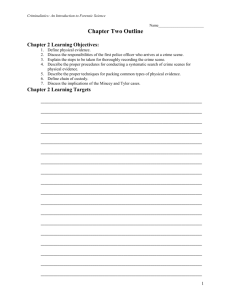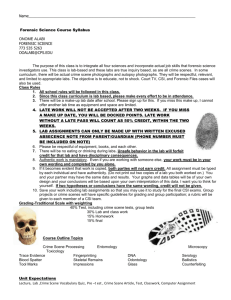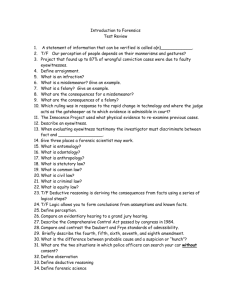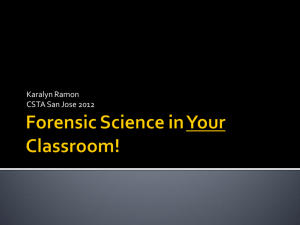Forensic Science Syllabus-student version2
advertisement
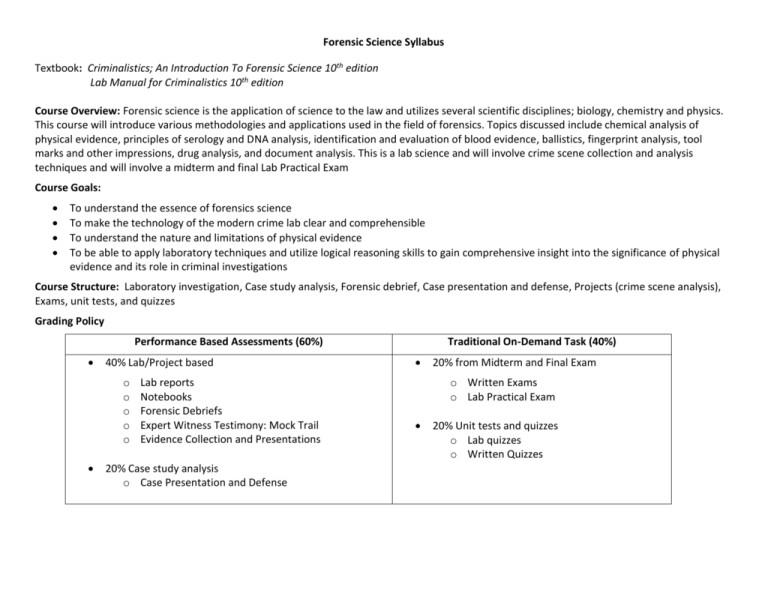
Forensic Science Syllabus Textbook: Criminalistics; An Introduction To Forensic Science 10th edition Lab Manual for Criminalistics 10th edition Course Overview: Forensic science is the application of science to the law and utilizes several scientific disciplines; biology, chemistry and physics. This course will introduce various methodologies and applications used in the field of forensics. Topics discussed include chemical analysis of physical evidence, principles of serology and DNA analysis, identification and evaluation of blood evidence, ballistics, fingerprint analysis, tool marks and other impressions, drug analysis, and document analysis. This is a lab science and will involve crime scene collection and analysis techniques and will involve a midterm and final Lab Practical Exam Course Goals: To understand the essence of forensics science To make the technology of the modern crime lab clear and comprehensible To understand the nature and limitations of physical evidence To be able to apply laboratory techniques and utilize logical reasoning skills to gain comprehensive insight into the significance of physical evidence and its role in criminal investigations Course Structure: Laboratory investigation, Case study analysis, Forensic debrief, Case presentation and defense, Projects (crime scene analysis), Exams, unit tests, and quizzes Grading Policy Performance Based Assessments (60%) 40% Lab/Project based o o o o o Lab reports Notebooks Forensic Debriefs Expert Witness Testimony: Mock Trail Evidence Collection and Presentations 20% Case study analysis o Case Presentation and Defense Traditional On-Demand Task (40%) 20% from Midterm and Final Exam o Written Exams o Lab Practical Exam 20% Unit tests and quizzes o Lab quizzes o Written Quizzes Curriculum Review of Lab Safety Define and distinguish forensics and criminalistics understand Beryillon’s system of identification Demonstrate lab safety Practice Lab measurements Describe the services of a typical comprehensive crime lab explain the role and responsibilities of the expert witness -Analysis of Dr Coppolino’s case Use the steps of the scientific method to problem solve -Define Physical Evidence -Describe Responsibilities of 1st responder -Steps for Processing the crime scene -Procedures for Conducting a systematic search for physical evidence -Collecting and packaging physical evidence -Mock crime scene: what to collect, how, labeling, bagging and documenting (photo and sketch) Handling, transporting and submitting evidence -chain of evidence -maintaining safety, legal considerations Review common types of evidence Understand the significance of physical evidence and compare and contrast identification and comparison of physical evidence Identification vs comparison, individual vs class Assessing the significance and value of Physical Evidence List and explain the function of Forensic Databases Explain importance of pathologists, anthropologists and entomologists -Define and understand the properties of density and refractive index Exploring objects in water (activity) Refraction -procedures to ID glass evidence -List important Forensic properties of soil Unit 3 :Physical Properties of Glass, Organic and Inorganic Analysis of Evidence Unit 2: The Crime Scene Unit 1: Intro. CHAPTERS/ TOPICS Learning Objectives SUGGESTED READINGS Labs, Activities and Assignments Project 1, part 1 and 2 - WEBEXTRA 1. 2-3, 1.6, 1.7 “The Deadly Picnic” solution -Case Study; Dr. Coppolino - HW:Unit Review Questions Class WIKI Review -Lab #1: “Practice in Making Measurements” -Processing the crime scene Criminalistics ; Ch 1 Criminalistics: Ch 2 Mock Crime Scene: Securing, Isolating and Recording the crime scene -Case study analysis -quiz: the crime scene Similarities and Differences between Identification and Comparison of Evidence Criminalistics: Ch 3 -Forensic briefs -WEBEXTRA 3.1: Scott Peterson Case -WEBCASE 3.2 Autopsy - Case study analysis Unit Review Questions Project 2 :The Crime Scene Unit 2: Test HW: Pre-lab #3 Lab #3: “Physical Properties of glass” Quiz: Properties of Refractive index Formal Lab Report HW: pre-lab #4 Lab #4: “Soil Analysis” Poster Presentation Forensic Brief Criminalistics: Ch 4 Unit 4: Drugs and Forensic Toxicology Unit 5:Forensic Serology and DNA Evidence Understand the difference between qualitative and quantitative analysis Describe process of Chromatography and identify different types Understand the differences between the wave and particle theories of light Describe the utility of UV and IR spectroscopy for the ID of organic Compounds Describe the concept and utility of mass spec for ID analysis -Describe the usefulness of trace elements in forensics -Kennedy Assassination evidence analysis -Examine photon emissions as method of ID -Explain Neutron Activation analysis -understand importance in “death by Radiation Poisoning” case Explain the process and limitations of x-ray diffraction -Nuclear Forensics debrief -Application and critical thinking -The types and applications of microscopy in forensics science -Explain differences in microscopes and identify applications of each in forensics -Drugs; Dependence, Laws, Identification, Collection and Preservation of Drug Evidence: Methods for Detecting and Identifying Drugs -Name and classify commonly abused drugs -Collecting and Preserving Drug Evidence -Describe the lab tests used to perform routine drug id analysis - Explain Drug Control Laws Forensic Toxicology: Testing for Intoxication and Human Metabolism -Collection and Preservation Of Blood Evidence, documenting drug influence -Understanding the components of the Drug Recognition Process -Classification of Blood Samples using pH, Hair Samples and Drugs HW: pre-lab#5 Lab #5: “Analysis of Ink by Paper Chromatography -Chem Minilab: Photon Emissions Lab -Kennedy Assassination Evidence Analysis -Quiz key terms ch 5 and 6 -Lab #6:”Practice in the Use of the Microscope” -WEBEXTRA 7.2, 7.4, Exploring Microscopes -Forensics Debrief Unit 3 Review Questions Unit 3 TEST Forensic Debrief Case Study Analysis and Presentation Drug Evidence Classifications and Preservation Questions: application and critical thinking (p181-182 #1-4 ) WEBEXTRA 7.6-7,7.8 Exploring Microscopes Virtual Forensics Lab: Drug Identification WEBEXTRA 9.1,9.2 Blood-alcohol levels and behavior Unit Review Questions Midterm Exam Review! PROJECT 3 Criminalistics: Ch 5 Criminalistics: Ch 6 Criminalistics: Ch 7 and 8 Criminalistics: Ch 8 and 9 Forensic Serology; Blood composition and Types(p242-244) Explain blood cell physiology Describe the process of typing whole blood Typing blood samples(p242-245) Characterization of Bloodstains through forensic testing; determining source Describe tests to characterize a stain as blood Understand concepts of antigen-antibody interactions and application to species and drug identification chromosome vs genes anatomically using Punnett squares to determine genotype and phenotype Genetic analysis from blood and semen samples Collection and Preservation of Rape Evidence Lab tests to characterize semen samples, proper collection of evidence in sexual assault cases, -processing the crime scene with Blood and semen stains Lab Practicum; Mid-term Chapter 10 Prelab Lab #7: Blood Id and Typing Mid-term Exam (ch1-9) Lab #7: Blood Id and Typing Punnett Squares to predict Characteristics The structure of DNA WebExtra 11.3-4 CODIS STRs and Frequency of Occurrence of aDNA profile Contrast protein codes and repeating base sequences WebExtra 10.7 Punnet Squares Application and critical thinking Questions p262 Virtual lab: conduct an analysis of a bloodstain(p260) Pre-lab;Lab #8 Chapter 11 Polymerase Chain Reaction Technology and DNA Typing; STRs Lab #8 : Nuclear DNA Extraction Explain difference between nuclear and Michondrial DNA Pre-lab: Lab #9 Lab#9 -DNA fingerprinting Collection and Preservation of Biological Evidence for DNA Aalysis: collecting, packing and obtaining specimens Pre-lab: Lab #10 Lab #10: PCR Amplification of DNA The JonBenet Ramsey Case Analysis OJ Simpson Case and Forensics and 9/11/01 Case Studies Unit 5 Review Questions Unit 5 Test ch 10-11 Unit 6: Crime Scene Reconstruction ; Bloodstain, Hair, Fiber and Paint Analysis Crime scene Reconstruction: Bloodstain Pattern Analysis Fundamentals of Crime Scene Reconstruction General Features of Bloodstain Formation, Impact Spatter Patterns -angle of impact -origin of impact patterns -understanding how different pattern types are created and which features can aid reconstruction of crime scenes Documenting Bloodstain Evidence at a crime scene Hairs, Fibers and Paint The morphology of Hair Criminalistics: Ch 12 Lab #11: Determination of Blood Splatter Angles of Impact Virtual Lab: Blood Splatter Evidence Lab#12: Determining the Origin of Blood Splatters Virtual Forensics Lab: Blood Splatter evidence HW: Application and Critical thinking #2 and 3 Criminalistics: Ch 13 Pre-lab# 13 Lab#13: Examination of Hair by Microscopy, pt a,b and c Collection and Preservation of Hair Evidence Properties of Fibers, natural vs Manufactured -usefulness in forensics Forensic Examination of Paint IR Spec analysis and composition Collection and preservation of paint Forensics of Fire Investigations -conditions for initiation and sustaining combustion -recognizing signs of heat transfer Collecting physical evidence at arson scene Understand Lab procedures for hydrocarbon residue detection Forensic Investigation of Explosives classification of explosives Identifying common explosives, commercial, military and homemade Collection and Analysis of Evidence of Explosives Unit 7: Forensic Aspects of Fire, Explosive, Fingerprint, Firearms, Toolmarks and Impressions in Investigations Application and critical thinking Question #1,a,b,c Fingerprints Fundamental Principles of Fingerprinting Recognizing common ridge characteristics Identify 3 major fingerprint patterns and their subclasses Distinguish visible, plastic and latent fingerprints Understand Concept of Automated fingerprint identification systems Methods for detecting fingerprints Virtual Forensics Lab: Fiber Analysis -Application and critical thinking questions # 1-5 Criminalistics: Ch 14 PROJECT 4 Unit 6 Review Questios Unit 6 Test Ch12-14 Criminalistics: Ch 15 -Questions: application and critical thinking (p370) #1-3 -HW: Application of critical thinking, P387, #1-3 Pre-lab #14 Lab #14: Fingerprinting ( a-e) Questions: Application and Critical thinking (p414) #1-4 Criminalistics: Ch 16 Unit 8: Final Project an Assessment Firearms, tool marks and other impressions Evaluate bullet and cartridge comparisons Identify rifiling a barrel Recognize class and characteristics of bullets and cartridge cases Understanding microscopic comparisons of bullets and cartridge cases Explain NIBIN database Explain the procedure to determine how far a weapon was fired from a target ID lab test to determine if a person fired a weapon -primer residue tests Explain Procedures for collection and preservation of firearms evidence Identify forensic significance of characterizing tool marks, foot and tire impressions Define “questioned document” Identify common individual characteristics of handwriting List guidelines for collecting known writings for comparison Recognize class and characteristics of printers and photocopiers List techs document examiners use to uncover alterations, erasures, obliterations and variations in pen inks FINAL PROJECT- MOCK CRIME SCENE •use all the techniques learned, to solve a mock crime: -fingerprint dusting -blood spatter analysis -drug identification -documentation of the crime scene -sketching the scene -photographing the scene -foot print analysis •Write a scenario based on the evidence •Use analysis of data collected at the scene to determine the perpetrator •Demonstrate through gathering evidence, documentation of crime scene and analysis of evidence that they have learned the skills required to be a Forensic Scientist -WEBEXTRA 17.7 casting footwear impression -Virtual Forensic Lab -tool mark analysis -footwear impressions Lab #15 -comparison of toolmarks and casting Lab #16 : Reproducing Bite marks HW: Virtual Forensics Lab- Thin-layer Chromatography of ink Final Exam Review Questions/Study Guide Lab final FINAL PROJECT Final Exam Criminalistics: Ch17 18

